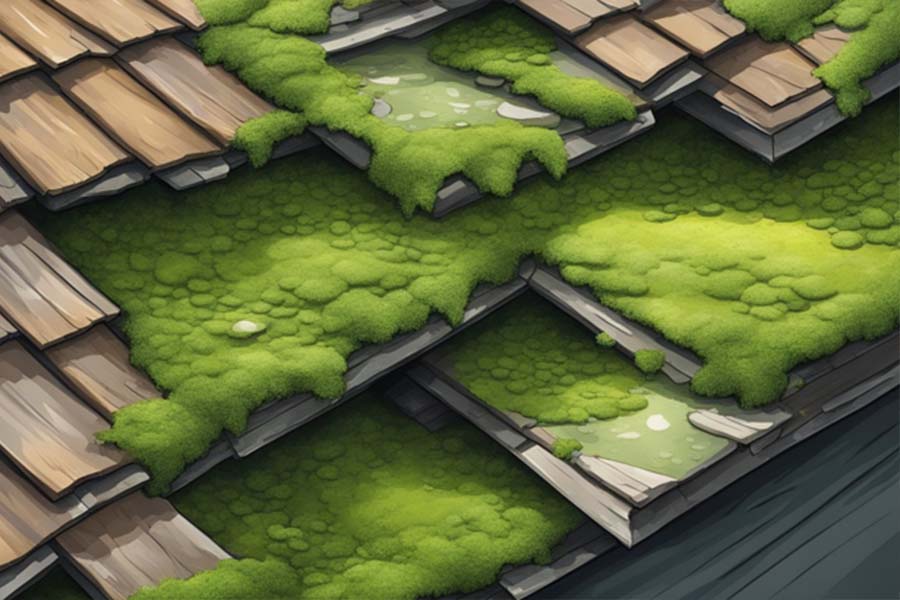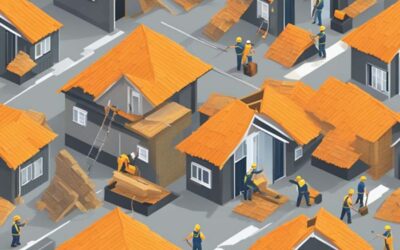Moss and algae growth on roofs is a common problem that can lead to serious damage if left untreated. While some homeowners may view these organisms as harmless, they can actually cause significant harm to the structural integrity of a roof. In this article, we will explore how moss and algae can cause serious damage to a roof and what homeowners can do to prevent it.
Moss and algae are two types of organisms that can grow on roofs. Moss is a type of plant that thrives in damp environments, while algae is a type of single-celled organism that grows in moist conditions. When these organisms take root on a roof, they can cause damage in a number of ways. For example, moss can grow between shingles and lift them up, allowing water to seep into the roof. Algae can also trap moisture against the roof, which can lead to rot and decay over time.
The Basics of Moss and Algae Growth on Roofs
Moss and algae are common types of plant growths that can be found on roofs. They can cause serious damage to the roof if left untreated. Understanding the basics of moss and algae growth on roofs can help homeowners prevent and treat this issue.
What is Moss?
Moss is a type of plant that grows in damp and shaded areas. It is a non-vascular plant that lacks roots, stems, and leaves. Moss can grow on various surfaces, including roofs, and can cause damage by retaining moisture and blocking drainage systems.
What is Algae?
Algae is a type of plant-like organism that can grow on various surfaces, including roofs. It thrives in damp and warm environments and can cause damage by retaining moisture and breaking down roofing materials.
How Do They Grow on Roofs?
Moss and algae can grow on roofs when spores are carried by wind or animals and land on the roof’s surface. They can also grow when there is an abundance of moisture and lack of sunlight on the roof. This can happen due to factors such as overhanging trees, clogged gutters, or poor ventilation.
The Damage They Can Cause
Moss and algae can cause serious damage to roofs if left untreated. They can retain moisture, which can lead to the growth of mold and mildew. This can weaken the roof’s structure and cause leaks. Additionally, moss and algae can break down roofing materials, which can lead to the need for costly repairs or even a full roof replacement.
Overall, understanding the basics of moss and algae growth on roofs can help homeowners prevent and treat this issue. Regular roof maintenance, such as cleaning gutters and trimming overhanging trees, can help prevent the growth of moss and algae. If moss and algae are already present, homeowners should consider hiring a professional to remove them safely and effectively.
Identifying Moss and Algae Damage on Roofs
Moss and algae can cause serious damage to roofs if left untreated. It is important to identify the signs of moss and algae growth on your roof early on to prevent any potential damage.
Signs of Moss Growth
Moss growth on a roof can be identified by its green and fuzzy appearance. It usually grows in shaded or moist areas of the roof and can spread quickly if left unchecked. Moss can also retain moisture, which can lead to water damage and rotting of the roof.
Signs of Algae Growth
Algae growth on a roof can be identified by its black or green appearance. It usually grows in areas of the roof that receive a lot of sunlight and can spread quickly if left untreated. Algae can also retain moisture, which can lead to water damage and rotting of the roof.
Checking for Damage
To check for damage caused by moss and algae growth, it is important to inspect the roof regularly. Look for any signs of discoloration, rotting, or warping of the roof. Check for any loose or missing shingles, as this can be a sign of water damage. It is also important to check the gutters for any buildup of moss or algae, as this can cause clogs and lead to water damage.
Prevention and Treatment
Preventing moss and algae growth on a roof can be done by trimming overhanging trees and removing any debris that may accumulate on the roof. Regular cleaning of the roof and gutters can also prevent buildup of moss and algae. If moss or algae growth is already present, it is important to have it professionally removed to prevent any further damage to the roof.
In conclusion, identifying moss and algae growth on a roof early on is crucial in preventing any potential damage. Regular inspections and maintenance can help ensure the longevity of your roof.
Factors Contributing to Moss and Algae Growth
Moss and algae growth on roofs is a common problem that can cause serious damage if left unaddressed. There are several factors that contribute to the growth of moss and algae on roofs, including:
- Moisture: Moss and algae thrive in damp environments, so roofs that are frequently exposed to rain, snow, or high humidity are more susceptible to growth. Additionally, shaded areas of the roof that receive less sunlight are more likely to retain moisture and provide a suitable environment for moss and algae to grow.
- Poor Drainage: Roofs with poor drainage can also contribute to moss and algae growth. When water is not able to properly drain off the roof, it can pool in certain areas and create a moist environment that is conducive to growth.
- Composition of Roofing Materials: Certain roofing materials, such as asphalt shingles, are more prone to moss and algae growth than others. This is because they contain organic materials that provide a food source for moss and algae.
- Lack of Maintenance: Regular maintenance, such as removing debris and cleaning gutters, can help prevent moss and algae growth on roofs. When debris and leaves accumulate on the roof, they can trap moisture and create a breeding ground for moss and algae.
It is important to address moss and algae growth on roofs as soon as possible to prevent further damage. Homeowners should consider hiring a professional roofing contractor to safely remove the moss and algae and take steps to prevent future growth.
The Impact of Moss and Algae on Roofing Materials
Shingle Deterioration
Moss and algae can cause serious damage to shingles on a roof. When moss and algae grow on shingles, they can trap moisture against the surface of the shingle. Over time, this moisture can cause the shingle to deteriorate, which can lead to leaks and other problems. In addition, as moss and algae grow, they can lift the shingles, which can allow water to seep underneath and cause even more damage.
Tile Damage
Moss and algae can also damage tile roofs. When moss and algae grow on tile roofs, they can trap moisture against the surface of the tile. This moisture can cause the tile to crack or break, which can lead to leaks and other problems. In addition, as moss and algae grow, they can lift the tiles, which can allow water to seep underneath and cause even more damage.
Corrosion of Metal Roofs
Moss and algae can also cause serious damage to metal roofs. When moss and algae grow on a metal roof, they can trap moisture against the surface of the metal. Over time, this moisture can cause the metal to corrode, which can lead to leaks and other problems. In addition, as moss and algae grow, they can lift the metal panels, which can allow water to seep underneath and cause even more damage.
It is important to regularly inspect your roof for signs of moss and algae growth, and to take steps to remove them as soon as possible. This can help prevent serious damage to your roofing materials and extend the life of your roof.
Prevention and Maintenance Strategies
Regular Cleaning
Regular cleaning is the most effective way to prevent moss and algae growth on roofs. A thorough cleaning should be done at least once a year, especially in areas with high humidity or frequent rainfall. Roof cleaning can be done using a pressure washer or a soft-bristled brush and a cleaning solution. It is important to avoid using high-pressure water or harsh chemicals that can damage the roof.
Proper Ventilation
Proper ventilation is essential to prevent moisture buildup on the roof, which can lead to moss and algae growth. Adequate ventilation allows air to circulate through the attic and roof space, reducing humidity levels. This can be achieved by installing vents or exhaust fans in the attic, as well as ensuring that the roof has proper intake ventilation.
Chemical Treatments
Chemical treatments can be used to prevent moss and algae growth on roofs. These treatments typically involve applying a solution to the roof that kills existing moss and algae and prevents new growth. It is important to choose a treatment that is safe for the roof and does not cause damage or discoloration.
Physical Barriers
Physical barriers can be installed on the roof to prevent moss and algae growth. These barriers can be in the form of zinc or copper strips that are installed along the ridge of the roof. As rainwater runs over these strips, it picks up small amounts of the metal, which inhibits moss and algae growth.
Overall, regular maintenance and prevention strategies are key to avoiding serious roof damage caused by moss and algae growth. By following these strategies, homeowners can ensure that their roofs remain in good condition and avoid costly repairs.
Professional Assessment and Remediation
When it comes to dealing with moss and algae damage on a roof, it is recommended to seek professional assessment and remediation services. Professional roofers have the knowledge, experience, and tools to properly identify the extent of the damage and provide effective solutions.
During the assessment, the roofer will inspect the roof for any signs of damage caused by moss and algae, such as discoloration, curling, and lifting of shingles. They will also check for any signs of water damage, as moss and algae can trap moisture and accelerate the deterioration of the roof.
Based on the assessment, the roofer will recommend the appropriate remediation method. This may include a thorough cleaning of the roof to remove the moss and algae, as well as any debris that has accumulated. In some cases, the roofer may also recommend the application of a protective coating to prevent future growth of moss and algae.
It is important to note that attempting to remove moss and algae on your own can be dangerous, as it involves working at heights and using specialized equipment. It can also cause further damage to the roof if not done properly. Therefore, it is highly recommended to leave it to the professionals.
In summary, professional assessment and remediation services are essential for addressing moss and algae damage on a roof. They can provide effective solutions to prevent further damage and prolong the life of the roof.
The Economic Implications of Neglecting Roof Maintenance
Neglecting roof maintenance can have serious economic implications for homeowners and businesses alike. Moss and algae growth on roofs can cause damage that leads to costly repairs or even roof replacement.
Roofs with moss and algae growth are more likely to develop leaks, which can lead to water damage inside the building. Water damage can be costly to repair, and can even lead to mold growth, which can be a health hazard and require professional remediation.
In addition to the cost of repairing water damage, neglecting roof maintenance can also lead to higher energy bills. Moss and algae growth can block gutters and downspouts, leading to water buildup on the roof. This water can seep into the building, causing damage and increasing humidity levels. High humidity levels can make it harder for HVAC systems to regulate temperature, leading to higher energy bills.
Finally, neglecting roof maintenance can also decrease the value of a property. A roof with moss and algae growth can be a red flag to potential buyers, who may assume that the roof has not been well-maintained. This can lead to lower offers and longer time on the market.
In summary, neglecting roof maintenance can have serious economic implications, including costly repairs, higher energy bills, and decreased property value. Homeowners and businesses should take steps to prevent moss and algae growth on their roofs to avoid these consequences.
Environmental Considerations and Solutions
When it comes to dealing with moss and algae on roofs, there are a few environmental considerations that should be taken into account. First and foremost, it’s important to understand that these organisms thrive in moist environments. This means that if your roof is shaded or doesn’t receive much direct sunlight, it’s more likely to develop moss or algae growth.
One way to combat this is to trim back any nearby trees or foliage that may be blocking sunlight from reaching your roof. Additionally, ensuring that your roof is properly ventilated can help to prevent moisture buildup and reduce the likelihood of moss and algae growth.
If moss or algae growth has already taken hold on your roof, there are several solutions that can help to remove it. One option is to use a pressure washer to blast away the growth. However, this method can be damaging to your roof and should only be done by a professional.
Another option is to use a chemical treatment specifically designed to kill moss and algae. These treatments are typically sprayed onto the affected areas and left to sit for a period of time before being rinsed off. It’s important to note that these treatments can also be harmful to the environment, so it’s important to choose a product that is eco-friendly.
Ultimately, the best way to prevent moss and algae growth on your roof is to take proactive measures to keep your roof clean and dry. This includes regular cleaning and maintenance, as well as ensuring that your roof is properly ventilated and receives adequate sunlight. By taking these steps, you can help to extend the life of your roof and prevent serious damage caused by moss and algae growth.





0 Comments